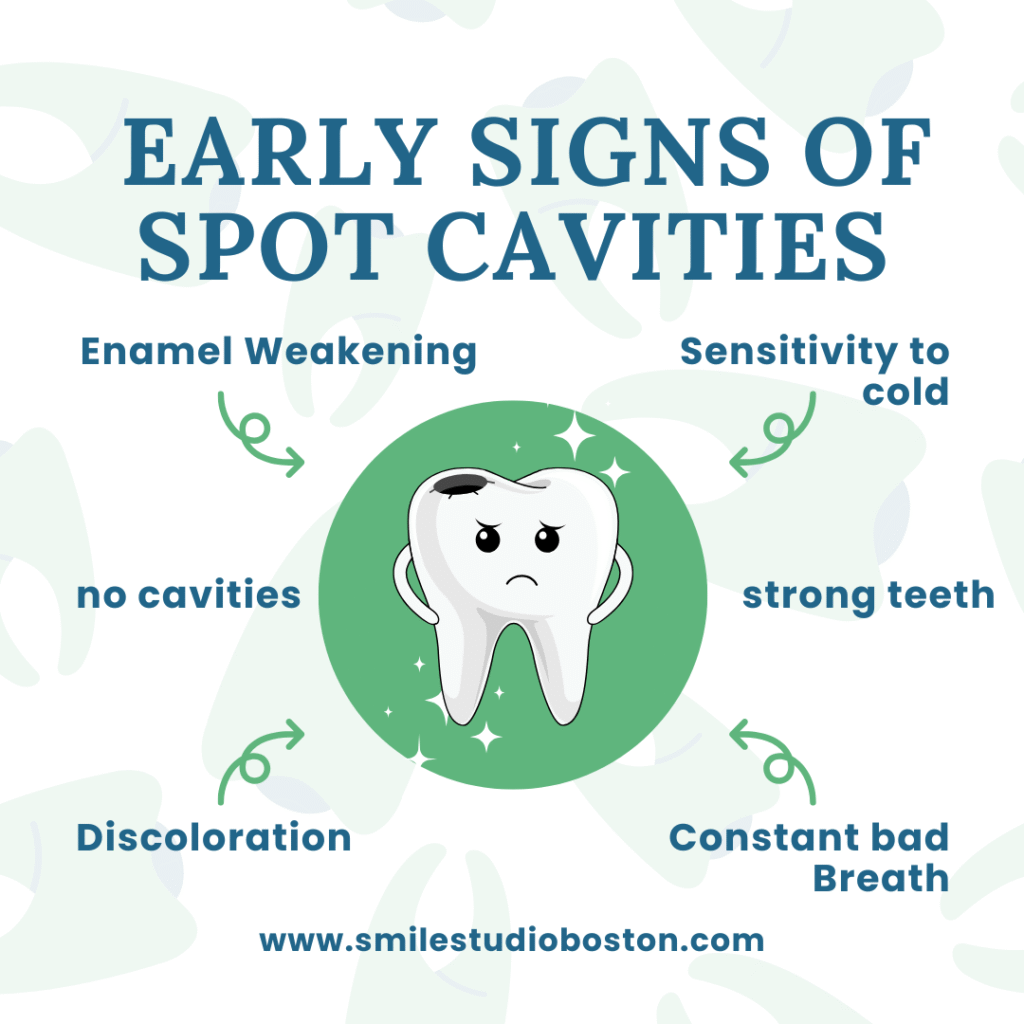1. What Are Cavities in Children?
Cavities in children develop when bacteria in the mouth produce acids that break down tooth enamel.
This process typically starts when food particles—especially sugars and starches—are left behind after eating or drinking. These particles feed the bacteria, which then form a sticky layer called plaque on the teeth. Over time, acid from this plaque attacks the enamel, leading to decay.
This condition is often referred to as pediatric tooth decay or early childhood caries, and it can begin as soon as a child’s first tooth appears. In Boston and beyond, many parents are surprised to learn that even toddlers are at risk.
If left untreated, these cavities can lead to serious issues—pain, infections, and even premature tooth loss. Children’s bad teeth can also interfere with speech development and the proper alignment of adult teeth later on.
Read More: Orthodontics For Kids: Why Start Early?
2. Why Do Cavities Form in Preschoolers?
For many Boston families, cavities can come as a surprise during a routine dental visit. But cavities in preschoolers are more widespread than most parents realize. Several everyday habits can quietly contribute to early decay.
- Frequent snacking throughout the day exposes teeth to constant sugar, creating the perfect environment for decay-causing bacteria.
- Sending a child to bed with a bottle or sippy cup filled with milk or juice allows sugar to sit on their teeth overnight, leading to enamel erosion.
- Inconsistent brushing or a lack of parental supervision during oral hygiene makes it easy for plaque to build up on tiny teeth.
- Bacteria can be transferred from caregivers to children by sharing spoons, cleaning pacifiers with their mouth, or blowing on food.
- Limited exposure to fluoride—either from toothpaste or drinking water—reduces the natural protection young teeth need against pediatric tooth decay.
Recent studies show that more than 20% of children aged 2 to 5 already have at least one cavity. This shows just how urgent it is to educate families on the risks and how to act early.
Read More: Children Dental Health and the Role of Preventive Visits

3. Early Signs: How to Spot Cavities
When it comes to kids cavities, early detection is key. Parents often miss the subtle signs, allowing decay to progress. Recognizing the first changes in your child’s teeth can help you take action before the problem worsens.
- White or dull spots on the surface of baby teeth, especially near the gumline, are often the first sign of enamel weakening.
- Sensitivity to cold, hot, or sweet foods might cause a child to flinch, avoid eating, or complain during meals.
- Discoloration, including brown or black marks or small pits, often appears when decay begins to break through the enamel.
- A constant bad breath or a sour taste in the mouth may be due to bacterial activity linked with pediatric tooth decay.
- Complaints of tooth pain, especially during chewing or at bedtime, could mean the cavity has reached a deeper layer of the tooth..
Being alert to these signs can help parents intervene early. If your child is showing any of these symptoms, it’s time to schedule a visit with SmileStudio Boston.
Read More: When to Take Baby to Dentist for Their First Visit
4. Prevention Strategies for Standing Against Cavities
Preventing cavities in children starts with daily habits that protect their teeth from a very young age.
- Brush your child’s teeth twice a day using fluoride toothpaste. For children under 3, use a rice-sized smear; from age 3 to 6, switch to a pea-sized amount.
- Introduce flossing as soon as two teeth touch. Daily flossing after age 2 helps clean plaque and food particles from between teeth—areas where pediatric tooth decay often begins.
- Offer tooth-friendly snacks between meals. Cheese, fresh fruits, crunchy vegetables, and plain water help neutralize acids and reduce plaque buildup.
- Consider dental sealants, especially for the back molars. These protective coatings fill the grooves where kids cavities often form and can reduce decay risk by up to 80%.
- Start regular dental visits early. The first checkup should happen by your child’s first birthday or when their first tooth appears.
Building these habits early helps keep childrens bad teeth at bay and encourages lifelong dental health.
Read More: Sealants on Molars: Why They Matter for Your Child’s Dental Health

5. Treatment Options for Pediatric Tooth Decay
Even with the best preventive efforts, cavities in children can still happen. The good news is that early treatment is often simple, painless, and highly effective—especially when caught in time.
- In the very early stages, when the enamel is just beginning to weaken, remineralization techniques and fluoride varnish may help reverse the decay without the need for drilling.
- Silver diamine fluoride (SDF) is a non-invasive treatment option that stops decay in its tracks, especially useful for younger children or those who may not tolerate fillings well.
- For more advanced decay, treatments may include fillings to restore the tooth’s shape, crowns for larger cavities, or a pulpotomy—a baby tooth version of a root canal—to save the tooth from infection.
Choosing the right treatment depends on the severity of the decay, the child’s age, and their comfort level.
Read More: Choosing the Right Pediatric Dentist for Your Child
6. Early Detection Matters
Early detection of cavities in children isn’t just about avoiding pain—it’s about preventing long-term consequences that affect a child’s overall well-being.
- Untreated decay can lead to infections, abscesses, and even damage to developing permanent teeth.
- Severe cases of pediatric tooth decay can cause misalignment, interfere with speech development, and make chewing uncomfortable, affecting your child’s nutrition.
- Dental problems can also impact a child’s confidence, especially when visible kids cavities or missing teeth begin to affect their smile.
- Catching and treating problems early saves money. Simple fluoride treatments or fillings are far less costly than crowns, root canals, or tooth extractions.
By staying aware and scheduling regular dental visits, Boston parents can give their children a healthy start—and a bright future—free from the burden of childrens bad teeth.
Healthy Habits Start at Home – And at SmileStudio Boston
If you’re a parent in Boston, now is the time to take a closer look at your child’s smile. Cavities in children can form before you even notice any symptoms, especially if your little one isn’t yet brushing independently.
At SmileStudio Boston, we welcome families looking for a trusted and gentle dental team. Whether you’re worried about cavities in preschoolers, want to prevent kids cavities, or simply need a checkup, our team is here to help. We offer preventive services like fluoride varnish and sealants in a warm, welcoming environment designed for young patients.
Your child’s dental health starts with awareness — and action. Don’t wait until you notice children’s bad teeth or complaints of pain. Schedule a pediatric screening today and let us support your journey toward a cavity-free smile.
📞 Call Us: +1 (617) 265-5606
📧 Email Us: smilestudioboston@gmail.com
🌐 Visit Our Website: https://smilestudioboston.com/
📍 Find Us: 1428 Dorchester Ave, Dorchester, MA 02122, United States
SmileStudio – Where Beautiful Smiles Begin. Join us on your journey to a healthier, more radiant smile. Book your appointment now!


